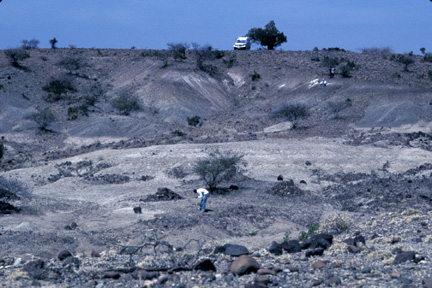

For years the going theory on bipedalism was that warming and drying of the climate caused forests to shift into grasslands, forcing tree-dwelling apes to begin walking on two feet, becoming hominids. But the oldest hominid fossils ever found — 5.54 to 5.77 million years — were excavated recently from geological deposits of a wet, wooded environment in the Afar rift of Ethiopia. In fact, no hominid fossil older than 4.4 million years has been found in an ancient savanna environment, causing paleontologists to rethink human origins.
In the July 12 Nature, geologist Giday WoldeGabriel of Los Alamos National Laboratory, doctoral student Yohannes Haile-Selassie of the University of California at Berkeley, and their colleagues reported on new evidence that hominids walked upright in a forested landscape between 5.8 and 5.2 million years ago. The study area is in the Middle Awash valley of the Afar rift, about 50 miles south of Hadar, where the 3.2-million-year-old “Lucy” was found.
The geological sites are located along the foothills of the western margin of the Afar rift, in ancient lake and river sediments. Today the region is hot and dry and the terrain steep and bushy. There are no roads, only footpaths and goat trails. “Yohannes and I walked enormous distances, moving from one window of exposed sediment to the next,” WoldeGabriel says. “We did this for two years before finding a jaw of a hominid among hundreds of fossilized animal remains in the fall of 1997.”

[[Right: The Alayla Hominid site in the Middle Awash, Ethiopia, where Yohannes Haile-Selassie found a Late Miocene jawbone in 1997.]]
Between 5 and 6 million years ago, the Middle Awash was 1,500 meters higher in elevation, cooler, wetter, with abundant trees and active volcanoes erupting lava and ash. The Adu-Asa Formation contains thick layers of river and lake sediments and phreatomagmatic ash deposits — units created during volcanic explosions caused by contact of magma with groundwater or shallow surface water. Supporting climatic evidence includes floral and isotopic evidence and pollen data from the Ocean Drilling Program in the Arabian Sea.
At the Asa Koma and Digba Dora hominid sites, low carbon isotope ratios in carbonates indicate woodland to grassy woodland. Low oxygen isotope ratios indicate cool, high altitude and possibly humid habitats. The abundance of reduncine bovids, a family that includes antelopes, oxen and sheep, also indicates the presence of woodland near lakes. Also, the rarity of fossilized hare remains in the entire Adu-Asa Formation indicates that no grasslands were present.
Five million-year-old sediments are hard to find though, especially ones containing fossils. Most of the Middle Awash study area is covered by lakes, forest, lava flows and recent alluvium. The rest contains patches of ancient sediments of different ages, exposed by intense faulting and subsequent erosion, when “the floor of the rift dropped and its shoulders fractured into uplifted and sunken fault blocks,” WoldeGabriel says. Even there, sediments containing mammal fossils crop out in small, scattered windows that amount to one percent of the study area.
The new hominid fossils come from the oldest of the exposed sedimentary patches, dated to be more than 5.2 million years old. Eleven hominid specimens have been recovered, mostly in fluvial deposits, including hand and foot bones, fragmentary arm bones and a piece of collarbone. The key bone, the one useful in establishing locomotion, is the January 2001 find of a 5.2 to 5.6 million-year-old toe bone similar to those found at Hadar. According to Haile-Selassie, this indicates that the creature was a biped, and arguably an evolutionary predecessor of Homo Sapiens.
Researchers determined the age of the fossils via volcanic layers dated using argon gas isotopes that are decay products of natural potassium trapped in volcanic rock after it cools. Geomagnetic polarity data and biochronological analysis of nearby animal fossils corroborated these results.
Craig Feibel, a Rutgers University anthropologist, says of the Middle Awash study, “It’s a small collection of fossils from a small locality, but it’s a first step.” He adds that a larger collection is needed to draw more absolute conclusions, and says that ancient lakes and rivers are common depositional environments and therefore more likely to preserve animal remains.
“It’s exactly what we expected,” says Lamont-Doherty geologist Peter deMenocal of WoldeGabriel’s conclusions. DeMenocal measures ocean deposits of wind-borne eolian dust from subtropical Africa to infer past aridity. The results of his data indicate that, “prior to 3 million years ago [the African climate] oscillated between very wet and somewhat less wet. There is no evidence of dry times.”
Emily D. Johnson
 |
Geotimes Home | AGI Home | Information Services | Geoscience Education | Public Policy | Programs | Publications | Careers |